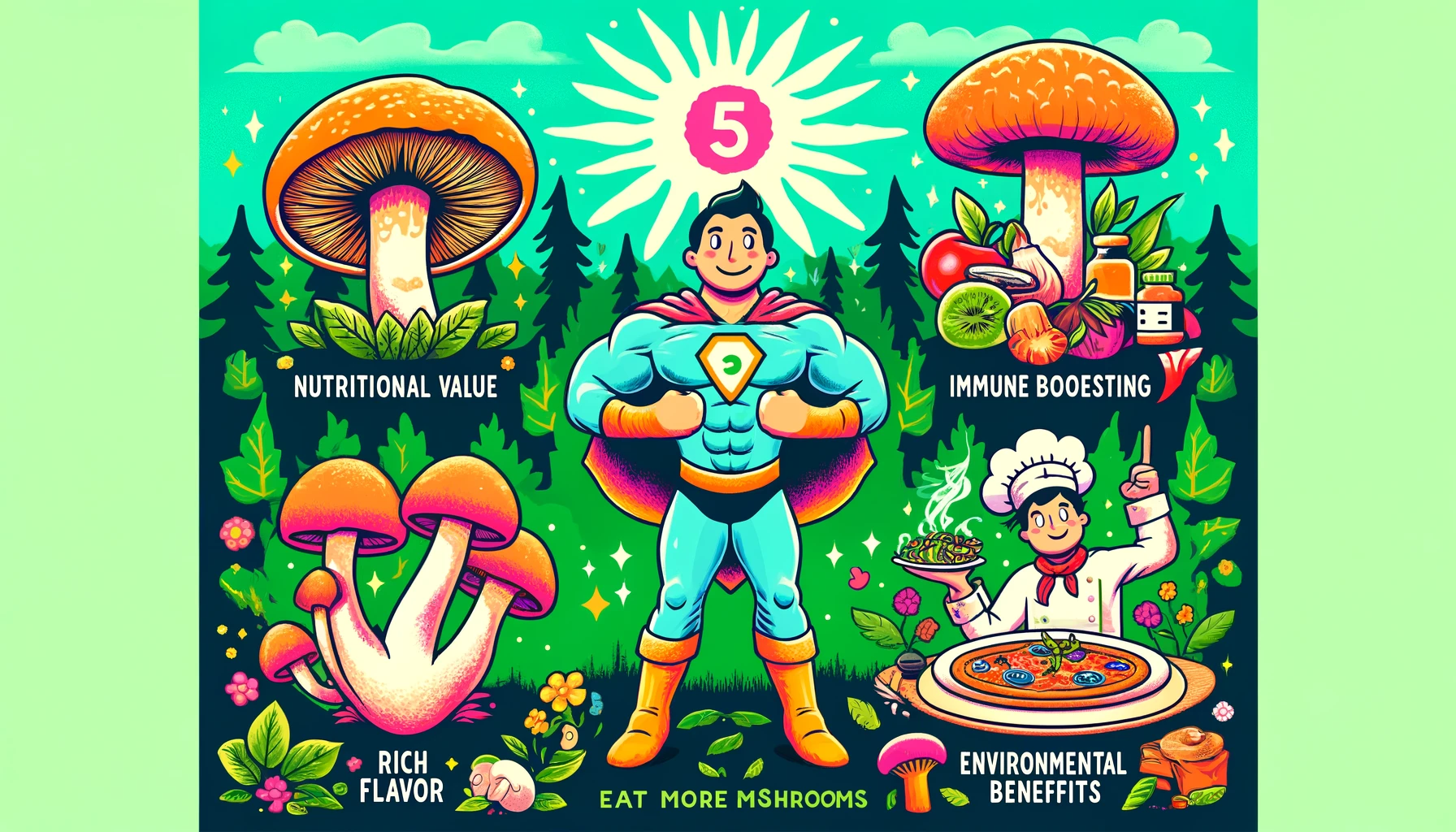The Five Reasons Why You Should Eat More Mushrooms

June 19, 2024
Mushrooms are continuing their reign as a major food choice due to their high nutrition, versatility, taste and sustainability. Whether fresh mushrooms, mushroom snacks or mushroom-based ingredients, this plant-based food is gaining in popularity. From their scientifically proven health benefits to their ability to mimic meat, mushrooms offer a variety of benefits that make them an essential addition to the diet. In this article, we will explore the top five reasons why you should incorporate more mushrooms into your diet.
Nutrient-Rich Plant Food
Mushrooms are the epitome of a nutritious food, which means you get a large amount of nutrients with very few calories. Raw mushrooms range between 19 and 31 calories for an 85-gram serving and contain no fat. In addition to being a plant source of B vitamins and essential minerals such as selenium and copper, mushrooms exposed to ultraviolet light also become a good source of vitamin D, one of the few vegan foods that contain it.
In addition, the fiber in mushrooms acts as a prebiotic, stimulating the growth of the gut microbiota. A specific type of soluble fiber found in mushrooms, called beta-glucans, is similar to the main fiber found in oats, which is beneficial for blood sugar and cholesterol management.
Satisfactory Meat Substitute
With their meaty texture and chewy bite, mushrooms have the impressive ability to mimic meat. It all started with a grilled portobello mushroom instead of a porterhouse steak. Now, the focus has shifted to maitake mushrooms, also called “chicken of the forest.” Maitakes are appearing on menus as vegetarian versions of fried chicken sandwiches, pulled pork, shawarma, chicken-fried steak and other dishes.
But it’s not just 100% plant-based foods. The Blended Burger Project®, started by the Mushroom Council, is a movement promoting the combination of finely chopped mushrooms with ground beef for burgers, patties, tacos, sloppy joes, meatloaf, and more. In addition, companies such as Both and Mush Foods are trying to make the concept of hybrid meats mainstream by combining plant proteins such as mushroom mycelium with meat, poultry, fish, or pork.
Scientifically Proven Health Benefits.
Long valued in traditional medicine practices around the world, mushrooms continue to be the subject of scientific research. Promising evidence suggests a positive impact of mushrooms on immune function, gut health, and weight management. Mushrooms contain prebiotic fiber and bioactive plant compounds such as polyphenols and flavonoids, which are associated with these benefits.
Studies have shown that mushrooms, when replacing meat, can improve weight loss, promote satiety, and improve nutrition. Some cell and animal studies also indicate potential anti-inflammatory and anti-cancer benefits, although the evidence is preliminary. In addition, psilocybin, a hallucinogenic compound found in some mushrooms, has been the subject of emerging research on the treatment of mental health disorders such as depression and anxiety.
Sustainable Cultivation
The unique way mushrooms are grown and recycled makes them one of the most sustainably produced foods in the country. Compared to other crops, mushrooms require minimal water and energy. They also take up a small amount of space to grow, helping to conserve soil and achieving high yields: one million pounds of mushrooms can grow each year on just 0.4 hectares of land.
In addition, mushrooms can be grown indoors year-round, so producers do not have to deal with the vagaries of weather or seasons. And if you substitute mushrooms for meat, you will further reduce the carbon footprint of your meal.
Tasty and Versatile Ingredient
Mushrooms are also an incredibly versatile ingredient that can be added raw to salads, grilled, baked, stir-fried in woks or cooked in soups — and added to foods as a side or main dish.
Mushrooms offer an umami flavor profile, which is a salty, complex flavor that has become a favorite of chefs. Umami is considered the fifth basic flavor, along with sweet, sour, salty and bitter. This same flavor is found in meats, fish and cheeses.
How to Eat Mushrooms
To start eating more mushrooms, here are some suggestions:
- Add dried mushrooms to stews, soups, sauces and gratins.
- Add sautéed mushrooms to pasta dishes, such as mac ‘n’ cheese.
- Grate or sauce large flat mushrooms (such as portobellos) and use them for a mushroom burger, garnished with caramelized onions and sliced cheese.
- Make a mushroom risotto with a mixture of fresh mushrooms and dried porcini mushrooms (soaked in hot water to rehydrate them).
- Saute sliced mushrooms in butter or olive oil, adding a drizzle of cream and chopped chives for classic mushrooms on toast.
- Fill large prataioli mushrooms with a mixture of bread crumbs, pesto and grated Parmesan cheese and bake until cooked.
- Season pizza with fresh sliced mushrooms sautéed in garlic.
- Add fresh sliced mushrooms to salads.
- Use reconstituted shiitake mushrooms, ginger and spring onions as a vegetarian filling for gnocchi.
Also, experiment with Blending, mixing finely chopped mushrooms with ground meat. The Mushroom Council recommends a 1-to-3 ratio of mushrooms to meat for burgers, patties and meatloaf, 1-to-1 for sloppy joes, tacos and burritos, and 3-to-1 ratio of mushrooms to meat for chili and sauces.
Common Types of Edible Mushrooms.
Here are some of the most common types of edible mushrooms:
White Champignon Mushrooms: These are the most popular variety in the United States, have a mild flavor and are small to medium in size.
Crimini Mushrooms: Also known as “baby bellas,” these mushrooms are similar to white champignons but have light brown caps and a deeper, earthier flavor.
Cantarelli: These mushrooms are golden in color with umbrella-shaped caps and curved stems.
Enoki: With long thin white stems and small white caps, these mushrooms can be eaten raw or cooked.
Maitake: Also known as “chicken of the forest,” these mushrooms have heads that resemble flowering leaves. They have a rich, woody flavor.
Morels: The cap of these species has an oblong spongy shape. Be careful when picking them, because another mushroom nicknamed “false morel” contains potentially dangerous toxins.
Oyster Mushrooms: These mild-flavored mushrooms get their name from the shell shape of their caps.
Porcini: They have a rounded red-brown cap with a thick cylindrical stem.
Portobello: A classic hamburger substitute, they have a large, thick brown cap with a rich, juicy flavor. They can also be served with grilled vegetables in a sandwich or alone with goat cheese and balsamic vinegar.
Shiitake: Often found in Asian cooking, they have a dark brown umbrella-like cap and a thin cream-colored stem.
Better Raw or Cooked?
Is it better to eat mushrooms raw or cooked? You can certainly enjoy raw mushrooms, especially in salads. Although there can be benefits to cooking them. The flavor is typically improved when you cook mushrooms and they are likely to be easier to digest than raw. Some evidence suggests that some nutrients in mushrooms are better absorbed when they are cooked. One study indicates that grilling and microwaving them helps preserve nutrients better than boiling and frying them.
Article source here.









